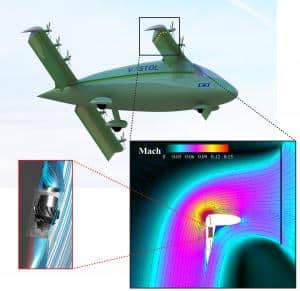Fig. 1: The eV/STOL vehicle hovering with deflected slipstream turned downward by coflow jet flap. Fig. 2: The eV/STOL vehicle at high efficiency crui
Transforming eV/STOL with deflected slipstream enabled by coflow jet flow control. "Tiltrotors, tiltwings, and lift plus may soon be part of history," CEO.
MIAMI, FLORIDA, USA, February 28, 2022 /EINPresswire.com/ — CoFlow Jet, LLC, a leading engineering and technology company specializing in active flow control using coflow jet (CFJ) technology for aerospace applications, announced today that they have entered a Joint Ownership Agreement (JOA) with NASA to commercialize the deflected slip-stream (DSS) technology enabled by coflow jet flow control. Jointly developed between NASA and CoFlow Jet, LLC., the technology would allow aircraft to take-off vertically, hover, smoothly transition to cruise and land vertically without using tiltrotors, tiltwings, or lift plus configuration. This would substantially simplify the vehicle system, reduce weight, increase range, save energy, and decrease noise. It would also combine vertical and short takeoff-landing (V/STOL), which facilitates aircraft to operate vertically within confined urban settings and further saves energy where there is a short runway space.
Commenting on the agreement, Dr. Gecheng Zha, CEO of CoFlow Jet, and professor at the University of Miami, said “We are developing advanced fully electric vertical and short takeoff and landing (eV/STOL) vehicles using DSS enabled by CFJ, which will make urban transportation and eCommerce economically viable. Tiltrotors, tiltwings, and lift plus may soon be part of history. Such a vehicle could also be used on Mars as it could generate nearly 10 times higher cruise lift coefficient compared to existing fixed wing aircraft, making it the most effective vehicle not only here on Earth but also on Mars where the air density is one-hundredth that of earth.”
Figure 1 shows the company designed concept vehicle. The vehicle is shown hovering with its flaps pointing downward and its propellers facing forward. The airflow from the propellers is turned vertically downward (see right inset) converting the entire thrust from the propellers to vertical lift. Unlike most of the current VTOL vehicles, the lift is generated without rotating the propellers upward. The 90 degree turn in the airflow is enabled by the coflow jet micro-compressors embedded in the flaps of all four wings (see left inset).
Once airborne, the flaps are rotated to align flush with the wings to provide smooth cruise flight. Figure 2 shows the tandem wing tailless eV/STOL vehicle at cruise. The figure is a simulated Mach contour plot from a NSF funded project using the company's high order scheme CFD (computational fluid dynamics) software. Figure 3 shows the micro-compressors embedded inside a CFJ wing that was recently tested in a DARPA funded wind tunnel experiment.
Overall a CFJ powered vehicle would enjoy high safety, long range, high efficiency, and low noise. Currently, the eV/STOL air vehicle preliminary design is complete and the company is seeking investors to join them in prototype manufacturing and flight demonstration. Morgan Stanley projects the eVTOL market to be $1 Tr by 2040 and $9 Tr by 2050.
“We envision to transform the aerospace industry with the superiority of coflow jet technology, which is a high impact fundamental technology and has been funded by multiple US government agencies. It is time to push this technology to the market to benefit the world. The eV/STOL is just the entry point for this endeavor. We welcome investors, industry, governments and other institutions to join us to make aviation history,” said Dr. Zha.
Acknowledgement:
This news release may include predictions, estimates or other information that might be considered forward-looking. While these forward-looking statements represent our current judgment on what the future holds, they are subject to risks and uncertainties that could cause actual results to differ materially. Readers are cautioned not to place undue reliance on these forward-looking statements, which reflect our opinions only as of the date of this release. Please keep in mind that we are not obligating ourselves to revise or publicly release the results of any revision to these forward-looking statements in light of new information or future events. This news release mentions some US government agencies who sponsored the research and development. The content of this release does not necessarily reflect the position or the policy of the United States Government, and no official endorsement should be inferred.
Gecheng Zha
Coflow Jet, LLC
gzha@coflowjet.com
Visit us on social media:
Facebook
Twitter
LinkedIn
![]()


